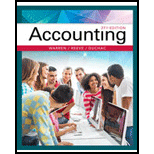
Concept explainers
1.
Cash dividends: The amount of cash provided by a corporation out of its distributable profits to its shareholders as a return for the amount invested by them is referred as cash dividends.
Common stock: These are the ordinary shares that a corporation issues to the investors in order to raise funds. In return, the investors receive a share of profit from the profits earned by the corporation. The dividend payments are not guaranteed and are paid after the payment made to the preferred stockholders.
Preferred stock: The stock that provides a fixed amount of return (dividend) to its stockholder before paying dividends to common stockholders is referred as preferred stock.
A preferred stock may be cumulative and non-cumulative. A cumulative preferred stock implies that a preferred stockholder is entitled to receive dividends for the current year plus any unpaid dividends of the previous years, before the dividends paid to the common stockholders.
Dividend per share:
Dividend per share represents the amount of dividend paid to each shareholders of the business.
To determine: The total dividends and the amount of dividends declared per share for preferred and common stock for each of the six years.
2.
The average annual dividend per share for each class of stock for the six-year period.
3.
The average annual percentage return on initial stockholders’ investment, based on the average annual dividend per share for (A) preferred stock and (B) common stock.
Trending nowThis is a popular solution!

Chapter 13 Solutions
Bundle: Accounting, 27th + Cengagenowv2, 2 Terms Printed Access Card
- Please solve and show work.arrow_forwardSequoia Resorts pays $780,000 plus $17,500 in closing costs to buy out a competitor. The real estate consists of land appraised at $95,000, a building appraised at $342,000, and recreational equipment appraised at $398,000. Compute the cost that should be allocated to the building.arrow_forwardI need help with this solution and general accounting questionarrow_forward
- Cozy Retreats currently sells 420 Standard hot tubs, 580 Luxury hot tubs, and 190 Premium model hot tubs each year. The firm is considering adding a Comfort model hot tub and expects that, if it does, it can sell 340 of them. However, if the new hot tub is added, standard sales are expected to decline to 290 units while Luxury sales are expected to decline to 310. The sales of the Premium model will not be affected. Standard hot tubs sell for an average of $8,900 each. Luxury hot tubs are priced at $14,500 and the Premium model sells for $22,000 each. The new Comfort model will sell for $12,300. What is the value of erosion?arrow_forwardSalma Production uses direct labor cost as the allocation base for applying MOH to WIP. The budgeted direct labor cost for the year was $850,000. The budgeted manufacturing overhead was $722,500. The actual direct labor cost for the year was $910,000. The actual manufacturing overhead was $745,000. A. What was Salma's predetermined manufacturing overhead rate per direct labor dollars? B. How much MOH was applied to WIP during the year?arrow_forwardHello tutor solve this question and accountingarrow_forward
- The total factory overhead for Leicester Manufacturing is budgeted for the year at $756,000. Leicester manufactures two product lines: standard lamps and premium lamps. These products each require 4 direct labor hours to manufacture. Each product is budgeted for 8,000 units of production for the year. Determine the factory overhead allocated per unit for premium lamps using the single plantwide factory overhead rate.arrow_forwardI need help with this solution and accounting questionarrow_forwardhttps://investor.exxonmobil.com/sec-filings/annual-reports/content/0000034088-25-000010/0000034088-25-000010.pdf Use link to help me answer my question please in picturearrow_forward
 College Accounting, Chapters 1-27AccountingISBN:9781337794756Author:HEINTZ, James A.Publisher:Cengage Learning,Principles of Accounting Volume 1AccountingISBN:9781947172685Author:OpenStaxPublisher:OpenStax College
College Accounting, Chapters 1-27AccountingISBN:9781337794756Author:HEINTZ, James A.Publisher:Cengage Learning,Principles of Accounting Volume 1AccountingISBN:9781947172685Author:OpenStaxPublisher:OpenStax College

